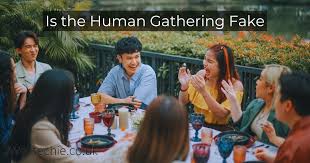The Human Gathering Fake News: Separating Facts from Fiction

Introduction to fake news and its impact on society
In today’s fast-paced digital world, the term “the human gathering fake” has become a buzzword that evokes strong reactions. From social media feeds to mainstream headlines, misinformation spreads like wildfire and impacts our understanding of reality. The Human Gathering Fake News: Separating Facts from Fiction explores how this phenomenon affects societies globally. We navigate through the murky waters of fact and fiction, uncovering the psychological triggers that lead people to consume fake news. With each click and share, we contribute to a complex web of beliefs shaping our culture the human gathering fake.
As consumers of information, it’s crucial for us to recognize the weight our choices carry in this landscape. It’s time to arm ourselves with tools for discernment and foster critical thinking skills. Join us as we delve deep into how you can spot misleading stories and take proactive steps in combating this pervasive issue.
The psychology behind fake news consumption
Fake news consumption often stems from deep-seated psychological factors. Humans are wired to seek information that confirms their existing beliefs. This tendency, known as confirmation bias, makes people more susceptible to misinformation the human gathering fake.
Emotions play a significant role, too. Headlines designed to provoke fear or outrage can spread rapidly because they trigger strong reactions. People are more likely to share content that elicits an emotional response, regardless of its truthfulness.
Social identity further complicates matters. Many individuals consume news through the lens of group affiliation— the human gathering fake what aligns with their social circle becomes acceptable and credible. This creates echo chambers where false narratives flourish unchecked.
Understanding these psychological drivers is crucial for addressing the issue of fake news consumption effectively. Awareness allows individuals to reflect on their own biases and motivations when engaging with information online.
How to spot and verify fake news sources
Spotting fake news sources requires a keen eye and critical thinking. Begin by examining the website’s domain. Established outlets usually end with “.com,” “.org,” or “.gov.” Be wary of unusual extensions that may indicate less credibility.
Next, check the author’s credentials the human gathering fake. Genuine articles should have a byline from someone qualified in the subject matter. If no name is provided, proceed with caution.
Look for supporting evidence within the article. Reliable news typically cites reputable sources or provides links to original research.
Also, consider the overall tone of the piece. Sensational language often signals bias or exaggeration.
Cross-reference information with multiple trusted publications before accepting it as fact. This practice not only verifies accuracy but also builds your ability to discern reliable reporting over time.
The role of social media in spreading fake news
Social media is a double-edged sword. It connects people, but it also amplifies misinformation at an alarming rate. A single tweet or post can reach millions in seconds.
Platforms like Facebook and Twitter allow users to share content without verification. This ease of sharing creates a perfect storm for fake news to flourish. Users often rely on sensational headlines rather than scrutinizing the source.
Algorithms further complicate matters by prioritizing engagement over accuracy. Content that elicits strong emotional reactions tends to go viral, regardless of its truthfulness.
The rapid spread of information can be overwhelming. Many individuals may not take the time to investigate before hitting “share.” As a result, false narratives gain traction swiftly.
This environment makes critical thinking essential for navigating our online interactions. Only through mindful consumption can we begin to slow the tide of misinformation flooding our feeds daily.
Case studies of viral fake news stories
One of the most notorious examples is the “Pope endorses Trump” story that circulated in 2016. This fabricated headline gained traction, influencing public perception during a critical election year. Millions shared it before fact-checkers debunked its authenticity.
Another striking case involved the viral claim that vaccines cause autism the human gathering fake. This myth persisted despite scientific evidence disproving any connection. The misinformation led to declining vaccination rates and outbreaks of preventable diseases.
Then there’s the “Florida Man” meme, which highlights bizarre crime stories attributed to individuals from Florida. While some stories are true, many are exaggerated or entirely false, feeding into stereotypes and skewing perceptions about residents.
These cases illustrate how easily fake news can spread and shape societal views, often with harmful consequences. Understanding these narratives helps us recognize patterns in misinformation that permeate our daily lives.
The importance of fact-checking and critical thinking skills
Fact-checking is crucial in the age of information overload. With countless articles, posts, and videos circulating online, it’s easy to get lost in a sea of misinformation.
Critical thinking skills empower individuals to analyze content thoroughly. Instead of accepting everything at face value, these skills encourage questioning and scrutiny. This approach helps discern credible sources from unreliable ones the human gathering fake.
Engaging with diverse perspectives can also sharpen critical thinking. By considering multiple viewpoints, we develop a balanced understanding of issues that matter most.
Moreover, fact-checking isn’t just about individual responsibility; it fosters informed communities. When people prioritize truthfulness over sensationalism, society benefits as a whole.
Equipping ourselves with these tools transforms how we interact with information daily. It encourages dialogue rooted in facts rather than fiction—a fundamental step toward combating fake news effectively.
Combating the spread of fake news: steps individuals can take
To effectively combat the spread of fake news, individuals can start by questioning the sources they encounter. Researching a headline or article can reveal its credibility and origin.
Engaging with trustworthy fact-checking websites is crucial. Platforms like Snopes, FactCheck.org, and PolitiFact provide valuable insights into viral claims.
Additionally, practicing healthy skepticism helps. If something seems too shocking or outrageous to be true, it’s worth pausing before sharing it.
It’s also important to diversify your news sources. Consuming information from various reputable outlets exposes you to different perspectives and lessens bias.
Fostering discussions about media literacy within your community encourages critical thinking skills in others as well. Sharing knowledge empowers everyone to discern truth from falsehood more effectively.
Conclusion: the responsibility of media outlets and consumers in combating fake news
As we navigate the complex landscape of information, both media outlets and consumers play crucial roles in combating fake news. Media organizations must prioritize accuracy and integrity in their reporting. They should implement rigorous fact-checking measures and provide transparent sources for their stories. By doing so, they foster trust and credibility with their audience.
On the other hand, consumers hold significant power as well. Developing critical thinking skills is essential when it comes to consuming content the human gathering fake. We need to question what we read, verify sources before sharing them on social media, and educate ourselves about the mechanics of misinformation.
Together, our collective efforts can create a more informed society where facts prevail over fiction. The responsibility lies not solely on one side but is shared between those who report the news and those who consume it. Awareness leads to action; by taking these steps seriously, we can diminish the influence of fake news in our lives and communities alike.





